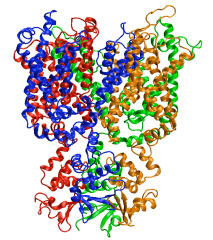
Protein Pores & Bilayers
 Protein pores are present in the membranes of all biological cells. They control the flow of ions and molecules into and out of the cell and provide the principal means for cells to communicate with their environment. These proteins are too small to directly insert into the aperture of a GNM, so we first create a planar lipid bilayer across the aperture of the GNM. Once a protein pore is inserted into the bilayer, we can then directly measure the flow of ions through the protein pore itself. The conductance of protein pores such as ion channels is very small so the amount of current through a single pore is also extremely small (pico-Amperes or ~1 trillionth of an Amp). The GNM based system developed by EBS allows for the measurement of these currents with exceptionally low noise and high bandwidth.
Protein pores are present in the membranes of all biological cells. They control the flow of ions and molecules into and out of the cell and provide the principal means for cells to communicate with their environment. These proteins are too small to directly insert into the aperture of a GNM, so we first create a planar lipid bilayer across the aperture of the GNM. Once a protein pore is inserted into the bilayer, we can then directly measure the flow of ions through the protein pore itself. The conductance of protein pores such as ion channels is very small so the amount of current through a single pore is also extremely small (pico-Amperes or ~1 trillionth of an Amp). The GNM based system developed by EBS allows for the measurement of these currents with exceptionally low noise and high bandwidth.
GNMs provide a number of other significant advantages when studying protein pores in planar lipid bilayers. The nanopore aperture of a GNM is much smaller than typical bilayer platforms and results in robust bilayers with very long lifetimes and immunity to vibration. Bilayers on GNMs withstand much higher voltages (750 mV) and pressures (300 mmHg) than those on other supports. The increased immunity to pressure across the bilayer allows for very fine control of protein incorporation into the bilayer by careful adjustment of the internal pressure of the GNM. EBS has also developed methods to automatically and reproducibly form bilayers on a GNM.
